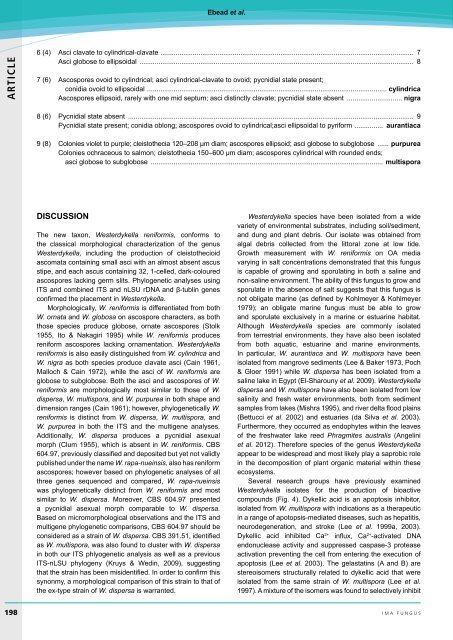Westerdykella reniformis sp. nov., producing the ... - IMA Fungus
Westerdykella reniformis sp. nov., producing the ... - IMA Fungus
Westerdykella reniformis sp. nov., producing the ... - IMA Fungus
You also want an ePaper? Increase the reach of your titles
YUMPU automatically turns print PDFs into web optimized ePapers that Google loves.
Ebead et al.<br />
ARTICLE<br />
6 (4) Asci clavate to cylindrical-clavate ...................................................................................................................................... 7<br />
Asci globose to ellipsoidal ................................................................................................................................................. 8<br />
7 (6) Asco<strong>sp</strong>ores ovoid to cylindrical; asci cylindrical-clavate to ovoid; pycnidial state present;<br />
conidia ovoid to ellipsoidal ............................................................................................................................... cylindrica<br />
Asco<strong>sp</strong>ores ellipsoid, rarely with one mid septum; asci distinctly clavate; pycnidial state absent .............................. nigra<br />
8 (6) Pycnidial state absent ....................................................................................................................................................... 9<br />
Pycnidial state present; conidia oblong; asco<strong>sp</strong>ores ovoid to cylindrical;asci ellipsoidal to pyriform ................ aurantiaca<br />
9 (8) Colonies violet to purple; cleisto<strong>the</strong>cia 120–208 µm diam; asco<strong>sp</strong>ores ellipsoid; asci globose to subglobose ....... purpurea<br />
Colonies ochraceous to salmon; cleisto<strong>the</strong>cia 150–600 µm diam; asco<strong>sp</strong>ores cylindrical with rounded ends;<br />
asci globose to subglobose ........................................................................................................................... multi<strong>sp</strong>ora<br />
DISCUSSION<br />
The new taxon, <strong>Westerdykella</strong> <strong>reniformis</strong>, conforms to<br />
<strong>the</strong> classical morphological characterization of <strong>the</strong> genus<br />
<strong>Westerdykella</strong>, including <strong>the</strong> production of cleisto<strong>the</strong>cioid<br />
ascomata containing small asci with an almost absent ascus<br />
stipe, and each ascus containing 32, 1-celled, dark-coloured<br />
asco<strong>sp</strong>ores lacking germ slits. Phylogenetic analyses using<br />
ITS and combined ITS and nLSU rDNA and β-tublin genes<br />
confirmed <strong>the</strong> placement in <strong>Westerdykella</strong>.<br />
Morphologically, W. <strong>reniformis</strong> is differentiated from both<br />
W. ornata and W. globosa on asco<strong>sp</strong>ore characters, as both<br />
those <strong>sp</strong>ecies produce globose, ornate asco<strong>sp</strong>ores (Stolk<br />
1955, Ito & Nakagiri 1995) while W. <strong>reniformis</strong> produces<br />
reniform asco<strong>sp</strong>ores lacking ornamentation. <strong>Westerdykella</strong><br />
<strong>reniformis</strong> is also easily distinguished from W. cylindrica and<br />
W. nigra as both <strong>sp</strong>ecies produce clavate asci (Cain 1961,<br />
Malloch & Cain 1972), while <strong>the</strong> asci of W. <strong>reniformis</strong> are<br />
globose to subglobose. Both <strong>the</strong> asci and asco<strong>sp</strong>ores of W.<br />
<strong>reniformis</strong> are morphologically most similar to those of W.<br />
di<strong>sp</strong>ersa, W. multi<strong>sp</strong>ora, and W. purpurea in both shape and<br />
dimension ranges (Cain 1961); however, phylogenetically W.<br />
<strong>reniformis</strong> is distinct from W. di<strong>sp</strong>ersa, W. multi<strong>sp</strong>ora, and<br />
W. purpurea in both <strong>the</strong> ITS and <strong>the</strong> multigene analyses.<br />
Additionally, W. di<strong>sp</strong>ersa produces a pycnidial asexual<br />
morph (Clum 1955), which is absent in W. <strong>reniformis</strong>. CBS<br />
604.97, previously classified and deposited but yet not validly<br />
published under <strong>the</strong> name W. rapa-nueinsis, also has reniform<br />
asco<strong>sp</strong>ores; however based on phylogenetic analyses of all<br />
three genes sequenced and compared, W. rapa-nueinsis<br />
was phylogenetically distinct from W. <strong>reniformis</strong> and most<br />
similar to W. di<strong>sp</strong>ersa. Moreover, CBS 604.97 presented<br />
a pycnidial asexual morph comparable to W. di<strong>sp</strong>ersa.<br />
Based on micromorphological observations and <strong>the</strong> ITS and<br />
multigene phylogenetic comparisons, CBS 604.97 should be<br />
considered as a strain of W. di<strong>sp</strong>ersa. CBS 391.51, identified<br />
as W. multi<strong>sp</strong>ora, was also found to cluster with W. di<strong>sp</strong>ersa<br />
in both our ITS phlyogenetic analysis as well as a previous<br />
ITS-nLSU phylogeny (Kruys & Wedin, 2009), suggesting<br />
that <strong>the</strong> strain has been misidentified. In order to confirm this<br />
synonmy, a morphological comparison of this strain to that of<br />
<strong>the</strong> ex-type strain of W. di<strong>sp</strong>ersa is warranted.<br />
<strong>Westerdykella</strong> <strong>sp</strong>ecies have been isolated from a wide<br />
variety of environmental substrates, including soil/sediment,<br />
and dung and plant debris. Our isolate was obtained from<br />
algal debris collected from <strong>the</strong> littoral zone at low tide.<br />
Growth measurement with W. <strong>reniformis</strong> on OA media<br />
varying in salt concentrations demonstrated that this fungus<br />
is capable of growing and <strong>sp</strong>orulating in both a saline and<br />
non-saline environment. The ability of this fungus to grow and<br />
<strong>sp</strong>orulate in <strong>the</strong> absence of salt suggests that this fungus is<br />
not obligate marine (as defined by Kohlmeyer & Kohlmeyer<br />
1979); an obligate marine fungus must be able to grow<br />
and <strong>sp</strong>orulate exclusively in a marine or estuarine habitat.<br />
Although <strong>Westerdykella</strong> <strong>sp</strong>ecies are commonly isolated<br />
from terrestrial environments, <strong>the</strong>y have also been isolated<br />
from both aquatic, estuarine and marine environments.<br />
In particular, W. aurantiaca and W. multi<strong>sp</strong>ora have been<br />
isolated from mangrove sediments (Lee & Baker 1973, Poch<br />
& Gloer 1991) while W. di<strong>sp</strong>ersa has been isolated from a<br />
saline lake in Egypt (El-Sharouny et al. 2009). <strong>Westerdykella</strong><br />
di<strong>sp</strong>ersa and W. multi<strong>sp</strong>ora have also been isolated from low<br />
salinity and fresh water environments, both from sediment<br />
samples from lakes (Mishra 1995), and river delta flood plains<br />
(Bettucci et al. 2002) and estuaries (da Silva et al. 2003).<br />
Fur<strong>the</strong>rmore, <strong>the</strong>y occurred as endophytes within <strong>the</strong> leaves<br />
of <strong>the</strong> freshwater lake reed Phragmites australis (Angelini<br />
et al. 2012). Therefore <strong>sp</strong>ecies of <strong>the</strong> genus <strong>Westerdykella</strong><br />
appear to be wide<strong>sp</strong>read and most likely play a saprobic role<br />
in <strong>the</strong> decomposition of plant organic material within <strong>the</strong>se<br />
ecosystems.<br />
Several research groups have previously examined<br />
<strong>Westerdykella</strong> isolates for <strong>the</strong> production of bioactive<br />
compounds (Fig. 4). Dykellic acid is an apoptosis inhibitor,<br />
isolated from W. multi<strong>sp</strong>ora with indications as a <strong>the</strong>rapeutic<br />
in a range of apotopsis-mediated diseases, such as hepatitis,<br />
neurodegeneration, and stroke (Lee et al. 1999a, 2003).<br />
Dykellic acid inhibited Ca 2+ influx, Ca 2+ -activated DNA<br />
endonuclease activity and suppressed ca<strong>sp</strong>ase-3 protease<br />
activation preventing <strong>the</strong> cell from entering <strong>the</strong> execution of<br />
apoptosis (Lee et al. 2003). The gelastatins (A and B) are<br />
stereoisomers structurally related to dykellic acid that were<br />
isolated from <strong>the</strong> same strain of W. multi<strong>sp</strong>ora (Lee et al.<br />
1997). A mixture of <strong>the</strong> isomers was found to selectively inhibit<br />
198 ima fUNGUS
















